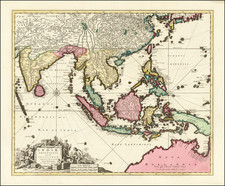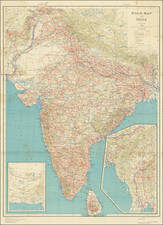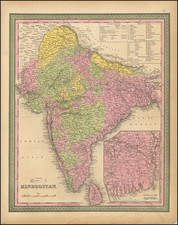Sri Lanka, As Known To The Greeks -- Taprobana
Fantastic woodcut map of Tabrobana (Sri Lanka) published in Ulm, Germany in 1486, showing the Classical cartography of the 2nd-century polymath Claudius Ptolemy.
The map was initially issued in Ulm in 1482, forming an integral part of the storied "Ulm Ptolemy" Geographia, the first atlas produced outside of Italy. The 1486 second edition is recognizable by the inclusion of the woodcut title ("Duodecima Asie Tabula") at the top of the map. This title is missing in the first edition. The text settings on the verso also change between editions.
The map is also the first map of the region printed north of the Alps, the first printed with a woodblock and the first to be issued with publisher's color.
The map is drawn from the work of Nicolas Germanicus, whose manuscript maps were created to illustrate pre-1470 editions of Ptolemy's Geographia.
The present map is from the second edition of this work, which was first published in 1482.
Taprobana
The earliest recorded note of Taprobana dates to before the time of Alexander the Great as inferred from Pliny. The treatise De Mundo (supposedly by Aristotle, but according to others by Chrysippus the Stoic (280 to 208 BC)) described an island the size of Great Britain. The name Taprobana seems to date to the Greek geographer Megasthenes around 290 BC. Eratosthenes (276 to 196 BC) references Taprobana in his Geographia. Ptolemy (139 AD) incorporates Taprobana in his geographical treatise, identifying it as a relatively large island south of continental Asia.
Taprobana was the home of the legendary single giant footed man-like creatures. G.U. Pope, in his book "Textbook of Indian History", claims the name to be derived from Dipu-Ravana, meaning the island of Ravana.
Historically, there was some debate over the location of Taprobana. Locations claimed included:
- Sri Lanka, as in Ptolemy's map and climes
- Sumatra, as in the birthplace of Enrique of Malacca
- A phantom island
While Ptolemy's Taprobane has been the subject of debate, it appears to be the present day Sri Lanka on the medieval maps of Abu-Rehan (1030) and Edrisi (1154) and as described by Marco Polo (1292). The tradition of the Middle Age use of Latinized placenames and delineating places with fanciful figures contributed to absurd designs and confusion regarding the island and Sumatra. In the fifteenth century, Niccolò de' Conti mistakenly identified Taprobana with a much smaller island. Taprobana/Ceylon/Sri Lanka is marked in the 1507 Martin Waldseemuller map.
The debate regarding the proper location of Ptolemy's Taprobana continues in Sebastian Munster’s Cosmographia of 1580, which incorporates a map of Taprobana with a title in German describing it as "Sumatra, a large island", although there was nothing that was available to Munster which warranted the re-opening of the Sri Lanka/Sumatra debate and this seems to be the final milestone in Taprobana's confused history.
The Ulm Ptolemy of 1482 and 1486
The Ulm edition of Ptolemy was first published in 1482 by Lienhart Holle. In contrast to the two earlier illustrated editions of Ptolemy's geography - Bologna (1477) and Rome (1478) - the maps in the Ulm edition are woodblock prints, not copperplate engravings. The maps in the Ulm edition follow the manuscript maps of Donnus Nicolaus Germanus, a Benedictine monk from Breslau who produced brilliant presentation copies for Italian elites in the 1460s and 1470s. Specifically, the Ulm was patterned after the manuscript atlas prepared for Pope Paul II. The Ulm Ptolemy was the first book Holle published, but it was also to be one of his last. Holle went bankrupt shortly after the original publication. The work was then taken over by Johann Reger, who issued another edition in 1486.
The differences between the two editions are relatively small. The 1486 maps typically include titles at the top, whereas there were no titles on the 1482 maps. An unpublished study of the individual maps reveals that there are multiple states of most of the maps.
It had long been suggested that the way to differentiate between the 1482 and 1486 editions was the use of lapis lazuli blue in the 1482 edition for the seas, whereas the 1486 used brown. However, the same unpublished study, which evaluated dozens of examples of the two editions, determined that the earliest examples of the 1486 were also issued with the lapis lazuli blue, suggesting that when Johann Reger acquired the woodblocks, he likely also acquired some unused lapis lazuli. In 2021, we offered for sale a complete example of a 1486 entirely in lapis lazuli blue.
Claudius Ptolemy (fl. AD 127-145) was an ancient geographer, astronomer, and mathematician. He is known today through translations and transcriptions of his work, but little is known about his life besides his residence in Alexandria.
Several of his works are still known today, although they have passed through several alterations and languages over the centuries. The Almagest, in thirteen books, discusses astronomy. It is in the Almagest that Ptolemy postulates his geocentric universe. His geometric ideas are contained in the Analemma, and his optical ideas were presented in five books known as the Optica.
His geographic and cartographic work was immensely influential. In the Planisphaerium, Ptolemy discusses the stereographic projection. Perhaps his best-known work is his Geographia, in eight books. However, Ptolemy’s ideas had been absent from western European intellectual history for roughly a thousand years, although Arab scholars interacted with his ideas from the ninth century onward.
In 1295, a Greek monk found a copy of Geographia in Constantinople; the emperor ordered a copy made and the Greek text began to circulate in eastern Europe. In 1393, a Byzantine diplomat brought a copy of the Geographia to Italy, where it was translated into Latin in 1406 and called the Cosmographia. The manuscript maps were first recorded in 1415. These manuscripts, of which there are over eighty extant today, are the descendants of Ptolemy’s work and a now-lost atlas consisting of a world map and 26 regional maps.
When Ptolemy’s work was re-introduced to Western scholarship, it proved radically influential for the understanding and appearance of maps. Ptolemy employs the concept of a graticule, uses latitude and longitude, and orients his maps to the north—concepts we take for granted today. The Geographia’s text is concerned with three main issues with regard to geography: the size and shape of the earth; map projection, i.e. how to represent the world’s curve proportionally on a plane surface; and the corruption of spatial data as it transfers from source to source. The text also contains instructions as to how to map the world on a globe or a plane surface, complete with the only set of geographic coordinates (8000 toponyms, 6400 with coordinates) to survive from the classical world.









![Il Disegno Della Terza Parte Dell' Asia [Gastaldi's Wall Map of SE Asia with extra panels!]](https://storage.googleapis.com/raremaps/img/small/30554hbp.jpg)
![[ Bombay ] Plan du Port de Bombay situe par 19 deg. de Lattit. Nord et par 70 deg. 41 min de Longit du Meridien de Paris](https://storage.googleapis.com/raremaps/img/small/95158.jpg)


![Northern Hindostan [with] Nepaul [with] Cabul](https://storage.googleapis.com/raremaps/img/small/62805.jpg)
